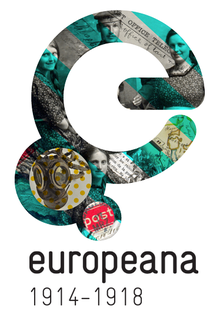Europeana/1914-18/Wikimedia Österreich
Europeana 1914-18 challenge in Austria[edit]

WWI has been a major focus in WMAT's Wikiversity cooperation with the University of Vienna over the past few years. Over time we conducted several university courses dedicated to this topic:
As the courses were part of the curricula of communication sciences at the university, the relationship between war and propaganda has been the main focus of these courses. Film was used during WWI as a mass media proganda instrument for the first time in history, hence a cooperation with the Filmarchiv Austria has been incorporated into the activities.
The project was very successful in terms of skill and knowledge transfer to new editors (students) and activating existing Wikimedians as mentors for the students. The cooperation with the Europeana and other GLAMs contributed to making history more tangible for the students and providing direct access to valuable sources and expert knowledge for their work on the Wikimedia projects.
Partners / GLAMs[edit]


- Filmarchiv Austria
- One of the first results was the article in the Wikipedia in German language: Heldenkampf in Schnee und Eis. See: Europeana 1914-18: Heldenkampf in Schnee und Eis
- Another example is the movie Der Kaiser bei unseren türkischen Verbündeten in de.Wikipedia: See: the German Bundesarchiv.
- Europaeana
- Heeresgeschichtliches Museum / Museum of Military History
- In cooperation with different departments of the museum the students got an overview about propagandistic paintings in the collections of the museum and their presentation in our time.
- Private collection of WWI propaganda posters, Erik Eybl. See: Commons Category: Plakatmuseum Wien, Eybl Collection
- "War on Wall" was on focus in three of the courses. See: Wikiversity articles: Ausstellung Krieg an der Wand (in German)
- University Library
- During the Summer Semester 2015 students curated the organisation of an exhibition of WWI propaganda posters at the library of the University of Vienna. Part of their work was the description of the posters for the exhibition as well as for Wikimedia Commons, where these posters were uploaded.
- War and Propaganda - Wikiversity Austria
-
Excursion to the Filmarchiv
-
Presentation at the Filmarchiv
-
Film cans at the archives
-
Edit-a-thon at the university
-
Poster exhibiton at the university
University courses "War and Propaganda during World War 1914-1918"[edit]


The three university courses between 2015 to 2017 on "War and Propaganda during World War 1914-1918" used Wikiversity as an education platform for cooperating students and wikipedians. The regular meetings at the Department of Communication at the University of Vienna, where the students had to be present, served as a basis for live presentations, discussions and edit-a-thons in German language Wikipedia. Wikimedia Commons was the database, where many pictures, made by students or collected by europaeana were hosted. During their 1914-1918 campaign, beginning in 2011 with collections and in 2012 with edit-a-thons in many countries of Europe, Europeana presented unique material, which was partly uploaded to Wikimedia Commons as a useful source for the students. After studying the sources in different archives in Vienna, their term papers had to be written in the style of Wikipedia articles on Wikiversity. Many articles, lacking in WIkipedia, were transferred there.
In Austria, where WW I began with the assassination of Archduke Franz Ferdinand of Austria and his wife, many Wikipedians felt, they could contribute to the presentation of the historic details of those world wide dramatic events. WMAT wanted to start already in 2012 and in 2013, when edit-a-thons took place at the Stockholm University in Sweden (See: http://pro.europeana.eu/blogpost/wikipedia-ww1-articles-enhanced-with-europeana-content Europeana Blog Posts]). But it was not before february 2015 when a framework was built up with GLAM institutions in Austria and the University of Vienna, to get many students involved in those projects. In the summer semester of 2015 a syllabus was ready for conduction at the Department of Communication. The course was repeated two times with a slightly different focus in winter 2015/16 and in winter 2016/17.
The work at archives and other institutions was not easy for the students. It turned out, that many documents had been loaned to other institutions in preparation for their own activities on WWI. The students were encouraged to write documentations on their collaboration with GLAM institution, to show up difficulties to the students of the next course (e.g. documentation on Bei unseren Helden an der Somme 1917 (Propagandafilm)). Easy to access were the contributions and collections of Europeana, e.g. on War Artists. Especially the uploads of pictures in Commons Category Europeana 1914-1918 were helpful. They show many Medals of Honor and Military Awards and Decorations the students had on focus in 2016/17. The courses will continue on phaleristics as a mean of propaganda. Other media were postcards and other publications.
New articles were published on artists of the Austrian Kriegspressequartier e. g. Ernst Zimmer (Maler) in Wikipedia or on Women in the Kriegspressequartier in Wikiversity. It was not easy to get informations about the women working as artists at the battlefields of World War I. An article Austrian weekly journal Die Muskete during World War I is an example of national stereotypes in the press during times of war.
The series of University courses about media and propaganda in the years 1914 to 1918 in cooperation with Wikipedians and Wikimedia projects will continue up to 2018.





